Microcalorimeters for X-Ray Spectroscopy of Highly Charged Ions at Storage Rings
Abstract
1. Introduction
2. Experimental Setup
2.1. Detection Principle
2.2. Silicon Microcalorimeters
2.2.1. Working Principle of Resistance Thermometers
2.2.2. Silicon Microcalorimeters for Hard X-rays
2.2.3. Cryogenic Setup
2.2.4. SiM-X: The Next Generation Silicon Microcalorimeter Array
2.3. Metallic Magnetic Calorimeters
2.3.1. Working Principle
2.3.2. The maXs Detector Arrays
2.3.3. Cryogenic Setup
3. Application in Experiments at the ESR
3.1. Experimental Procedure
3.2. First Application of Silicon Microcalorimeters
3.2.1. First Measurement at the ESR
3.2.2. Determination of the 1s Lamb Shift on Hydrogen-Like Lead and Gold Ions
3.2.3. First Tests for SiM-X
3.3. First Tests of Magnetic Calorimeters at the ESR
3.4. Next-Generation Detector Arrays
4. Conclusions and Perspectives
Author Contributions
Funding
Acknowledgments
Conflicts of Interest
Abbreviations
| GSI | GSI Helmholtz Centre for Heavy Ion Research |
| ESR | Experimental Storage Ring |
References
- Porter, F.S.; Beck, B.R.; Beiersdorfer, P.; Boyce, K.R.; Brown, G.V.; Chen, H.; Gygax, J.; Kahn, S.M.; Kelley, R.L.; Kilbourne, C.A.; et al. The XRS microcalorimeter spectrometer at the Livermore electron beam ion trap. Can. J. Phys. 2008, 86, 231–240. [Google Scholar] [CrossRef]
- Lamb, W.E.; Retherford, R.C. Fine structure of the hydrogen atom by a microwave method. Phys. Rev. 1947, 72, 241. [Google Scholar] [CrossRef]
- Niering, M.; Holzwarth, R.; Reichert, J.; Pokasov, P.; Udem, T.; Weitz, M.; Hänsch, T.W.; Lemonde, P.; Santarelli, G.; Abgrall, M.; et al. Measurement of the hydrogen 1S–2S transition frequency by phase coherent comparison with a microwave cesium fountain clock. Phys. Rev. Lett. 2000, 84, 5496. [Google Scholar] [CrossRef] [PubMed]
- Johnson, W.R.; Soff, G. The Lamb shift in hydrogen-like Atoms, 1 ≤ Z ≤ 110. Atom. Data Nucl. Data Tab. 1985, 33, 405. [Google Scholar] [CrossRef]
- Beier, T.; Mohr, P.; Persson, H.; Plunien, G.; Greiner, M.; Soff, G. Current status of Lamb shift predictions for heavy hydrogen-like ions. Phys. Lett. A 1997, 236, 329–338. [Google Scholar] [CrossRef]
- Yerokhin, V.A.; Shabaev, V.M. Lamb shift of n = 1 and n = 2 states of hydrogen-like atoms, 1 ≤ Z ≤ 110. J. Phys. Chem. Ref. Data 2015, 44, 033103. [Google Scholar] [CrossRef]
- Stöhlker, T.; Gumberidze, A.; Trassinelli, M.; Andrianov, V.; Beyer, H.F.; Kraft-Bermuth, S.; Bleile, A.; Egelhof, P.; The FOCAL collaboration. Quantum electrodynamics in extreme fields: Precision spectroscopy of high-Z H-like systems. Lect. Notes Phys. 2008, 745, 157–163. [Google Scholar]
- Beiersdorfer, P. Precision energy-level measurements and QED of highly charged ions. Can. J. Phys. 2009, 87, 9–14. [Google Scholar] [CrossRef]
- Beiersdorfer, P. Testing QED and atomic-nuclear interactions with high-Z ions. J. Phys. B 2010, 43, 074032. [Google Scholar] [CrossRef]
- Kubicek, K.; Mokler, P.H.; Mäckel, V.; Ullrich, J.; Lopez-Urrutia, J.R.C. Transition energy measureemnts in hydrogenlike and heliumlike ions strongly supporting bound-state QED calculations. Phys. Rev. A 2014, 90, 032508. [Google Scholar] [CrossRef]
- Beiersdorfer, P.; Britten, J.A.; Brown, G.V.; Chen, H.; Clothiaux, E.J.; Cottam, J.; Förster, E.; Gu, M.F.; Harris, C.L.; Kahn, S.M.; et al. Current research with highly charged ions in EBIT-II and SuperEBIT. Phys. Scr. T 2001, 92, 268. [Google Scholar] [CrossRef]
- Beiersdorfer, P. A “brief” history of spectroscopy on EBIT. Can. J. Phys. 2008, 86, 1–10. [Google Scholar] [CrossRef]
- Beiersdorfer, P. Highly charged ions in magnetic fusion plasmas: research opportunities and diagnostic necessities. J. Phys. B 2010, 48, 144017. [Google Scholar] [CrossRef]
- McDonald, J.W.; Bauer, R.W.; Schneider, D.H.G. Extraction of highly charged ions (up to 90+) from a high-energy electron-beam ion trap. Rev. Sci. Instrum. 2002, 73, 30–35. [Google Scholar] [CrossRef]
- Beiersdorfer, P.; Chen, H.; Thorn, D.B.; Träbert, E. Measurement of the two-loop Lamb Shift in lithiumlike U89+. Phys. Rev. Lett. 2005, 95, 233003. [Google Scholar] [CrossRef] [PubMed]
- Schweikhard, L.; Beiersdorfer, P.; Brown, G.V.; Lupez-Urrutia, J.R.C.; Utter, S.B.; Widmann, K. Pulsed gas injection for X-ray spectroscopy of highly charged ions stored in the magnetic trapping mode of an electron beam ion trap. Nucl. Instrum. Methods B 1998, 142, 245–252. [Google Scholar] [CrossRef]
- Marrs, R.E.; Elliot, S.R.; Knapp, D.A. Production and trapping of hydrogenlike and bare uranium ions in an electron beam ion trap. Phys. Rev. Lett. 1994, 72, 4082. [Google Scholar] [CrossRef] [PubMed]
- Eichler, J.; Stöhlker, T. Radiative electron capture in relativistic ion-atom collisions and the photoelectric effect in hydrogen-like high-Z systems. Phys. Rep. 2007, 439, 1–99. [Google Scholar] [CrossRef]
- Gumberidze, A.; Stöhlker, T.; Banas, D.; Beckert, K.; Beller, P.; Beyer, H.F.; Bosch, F.; Hagmann, S.; Kozhuharov, C.; Liesen, D.; et al. Quantum electrodynamics in strong electric fields: The ground-state Lamb shift in hydrogenlike uranium. Phys. Rev. Lett. 2005, 94, 223001. [Google Scholar] [CrossRef] [PubMed]
- Lestinsky, M.; Litvinov, Y. Physics book: CRYRING@ESR. Eur. Phys. J. Spec. Top. 2016, 225, 797–882. [Google Scholar] [CrossRef]
- Kluge, H.J.; Quint, W.; Winters, D.F.A. Atomic physics experiments with trapped and cooled highly charged ions. J. Phys. Conf. Ser. 2007, 58, 9. [Google Scholar] [CrossRef]
- Herfurth, F.; Andelkovic, Z.; Barth, W.; Chen, W.; Dahl, L.A.; Fedotova, S.; Gerhard, P.; Kaiser, M.; Kester, O.K.; Kluge, H.J.; et al. The HITRAP facility for slow highly charged ions. Phys. Scr. 2015, 166, 014065. [Google Scholar] [CrossRef]
- Geissel, H.; Armbruster, P.; Behr, K.H.; Brünle, A.; Burkard, K.; Cheng, M.; Folger, H.; Franczak, B.; Keller, H.; Klepper, O.; et al. The GSI projectile fragment separator (FRS): a versatile magnetic system for relativistic ions. Nucl. Instrum. Methods B 1992, 70, 286–297. [Google Scholar] [CrossRef]
- Facility for Antiproton and Ion Research in Europe GmbH (FAIR). Available online: www.fair-center.de (accessed on 26 October 2018).
- Stöhlker, T.; Litvinov, Y.A.; for the SPARC Collaboration. Atomic physics experiments at the high energy storage ring. Phys. Scr. T 2015, 166, 014025. [Google Scholar] [CrossRef]
- Stöhlker, T.; Bagnoud, V.; Blaum, K.; Blazevic, A.; Bräuning-Demian, A.; Durante, M.; Herfurth, F.; Lestinsky, M.; Litvinov, Y.; Nevv, S.; et al. APPA at FAIR: From fundamental to applied research. Nucl. Instrum. Methods B 2015, 365, 680–685. [Google Scholar] [CrossRef]
- Tashenov, S.; Banas, D.; Beyer, H.; Brandau, C.; Fritzsche, S.; Gumberidze, A.; Hagmann, S.; Hillenbrand, P.M.; Jörg, H.; Kozhuharov, I.; et al. Observation of coherence in the time-reversed relativistic photoelectric effect. Phys. Rev. Lett. 2014, 113, 113001. [Google Scholar] [CrossRef] [PubMed]
- Lopez-Urrutia, J.R.C.; Artemyev, A.; Braun, J.; Brenner, G.; Bruhns, H.; Draganic, I.N.; Martinez, A.J.G.; Lapierre, A.; Mironov, V.; Scofield, J.; et al. High precision measurements of forbidden transitions in highly charged ions at the Heidelberg EBIT. Nucl. Instrum. Methods B 2005, 235, 85–91. [Google Scholar] [CrossRef]
- Lapierre, A.; Lopez-Urrutia, J.R.C.; Baumann, T.M.; Epp, S.W.; Gonchar, A.; Gonzalez-Martinez, A.J.; Liang, G.; Rohr, A.; Orts, R.S.; Simon, M.C.; et al. Compact soft x-ray spectrometer for plasma diagnostics at the Heidelberg Electron Beam Ion Trap. Rev. Sci. Instrum. 2007, 78, 123105. [Google Scholar] [CrossRef] [PubMed]
- Biedermann, C.; Radtke, R.; Seidel, R.; Pütterich, T. Spectroscopy of highly charged tungsten ions relevant for fusion plasmas. Phys. Scr. T 2009, 134, 014026. [Google Scholar] [CrossRef]
- Amaro, P.; Szabo, C.I.; Schlesser, S.; Gumberidze, A.E.K., Jr.; Henins, A.; Bigot, E.O.L.; Trassinelli, M.; Isac, J.M.; Travers, P.; Guerra, M.; et al. A vacuum double-crystal spectrometer for reference-free X-ray spectroscopy of highly charged ions. Radiat. Phys. Chem. 2014, 98, 132–149. [Google Scholar] [CrossRef]
- Beyer, H.; Gassner, T.; Trassinelli, M.; Heß, R.; Spillmann, U.; Banas, D.; Blumenhagen, K.H.; Bosch, F.; Brandau, C.; Chen, W.; et al. Crystal optics for precision X-ray spectroscopy on highly-charged ions—Conception and proof. J. Phys. B 2015, 48, 144010. [Google Scholar] [CrossRef]
- Uhlig, J.; Doriese, W.B.; Fowler, J.W.; Swetz, D.S.; Jaye, C.; Fischer, D.A.; Reintsema, C.D.; Bennett, D.A.; Vale, L.R.; Mandal, U.; et al. High-resolution X-ray emission spectroscopy with transition-edge sensors: Present performance and future potential. J. Synchrotron Radiat. 2015, 22, 766–775. [Google Scholar] [CrossRef] [PubMed]
- Egelhof, P.; Beyer, H.F.; McCammon, D.; Felitzsch, F.V.; Kienlin, F.V.; Kluge, H.J.; Liesen, D.; Meier, J.; Moseley, S.H.; Stöhlker, T. Application of low temperature calorimeters for precise Lamb shift measurements in hydrogen-like very heavy ions. Nucl. Instrum. Methods A 1996, 370, 263–265. [Google Scholar] [CrossRef]
- Silver, E.; Schnopper, H.; Austin, G.; Ingram, R.; Guth, G.; Murray, S.; Madden, N.; Landis, D.; Beeman, J.; Haller, E.E.; et al. Using a microcalorimeter to measure the Lamb shift in hydrogenic gold and uranium on cooled, decelerated ion beams. Nucl. Instrum. Methods A 2004, 520, 60–62. [Google Scholar] [CrossRef]
- Mazin, B.A.; Bumble, B.; Day, P.K.; Eckart, M.E.; Golwala, S.; Zmuidzinas, J.; Harrison, F.A. Position sensitive x-ray spectrophotometer using microwave kinetic inductance detectors. Appl. Phys. Lett. 2006, 89, 222507. [Google Scholar] [CrossRef]
- Ulbricht, G.; Mazin, B.A.; Szypryt, P.; Walter, A.B.; Bockstiegel, C.; Bumble, B. High multiplexible thermal kinetic inductance detectors for x-ray imaging spectroscopy. Appl. Phys. Lett. 2015, 106, 251103. [Google Scholar] [CrossRef]
- Friedrich, S.; Segall, K.; Gaidis, M.C.; Wilson, C.M.; Prober, D.E.; Szymkowiak, A.E.; Moseley, S.H. Experimental quasiparticle dynamics in a superconducting, imaging x-ray spectrometer. Appl. Phys. Lett. 1997, 71, 3901–3903. [Google Scholar] [CrossRef]
- Friedrich, S. Superconducting tunnel junction photon detectors: Theory and Applications. J. Low Temp. Phys. 2008, 151, 277–286. [Google Scholar] [CrossRef]
- Enss, C. (Ed.) Cryogenic Particle Detection; Topics in Applied Physics Book Series; Springer: Berlin/Heidelberg, Germany, 2005; Volume 99. [Google Scholar]
- Camus, P.; Julliard, A. Low Temperature Detectors LTD-16. J. Low Temp. Phys. 2015, 185, 173706. [Google Scholar]
- Doriese, W.B.; Abbamonte, P.; Alpert, B.K.; Bennett, D.A.; Denison, E.V.; Fang, Y.; Fischer, D.A.; Fitzgerald, C.P.; Fowler, J.W.; Gard, J.D.; et al. A practical superconducting-microcalorimeter X-ray spectrometer for beamline and laboratory science. Rev. Sci. Instrum. 2017, 88, 053108. [Google Scholar] [CrossRef] [PubMed]
- Ullom, J.N.; Bennett, D.A. Review of superconducting transition-edge sensors for x-ray and gamma-ray spectroscopy. Supercond. Sci. Technol. 2015, 28, 084003. [Google Scholar] [CrossRef]
- Mott, N.F. Conduction in non-crystalline materials. Philos. Mag. 1969, 19, 835. [Google Scholar] [CrossRef]
- Stahle, C.; Kelley, R.L.; McCammon, D.; Moseley, S.H.; Szymkowiak, A.E. Microcalorimeter arrays for high resolution soft X-ray spectroscopy. Nucl. Instrum. Methods A 1996, 370, 173–176. [Google Scholar] [CrossRef]
- McCammon, D.; Almy, R.; Apodaca, E.; Tiest, W.B.; Cui, W.; Deiker, S.; Galeazzi, M.; Juda, M.; Lesser, A.; Mihara, T.; et al. A high spectral resolution observation of the soft x-ray diffusive background with thermal detectors. Astrophys. J. 2002, 576, 188. [Google Scholar] [CrossRef]
- Porter, F.S.; Brown, G.V.; Cottam, J. X-Ray Astronomy and Astrophysics. In Cryogenic Particle Detection; Topics in Applied Physics Book Series, Volume 99; Springer: Berlin/Heidelberg, Germany, 2005. [Google Scholar]
- Hitomi Collaboration; Aharonian, F. The Quiescent Intracluster Medium in the Core of the Perseus Cluster. Nature 2016, 535, 117–121. [Google Scholar]
- Porter, F.S.; Brown, G.V.; Boyce, K.R.; Kelley, R.L.; Kilbourne, C.A.; Beiersdorfer, P.; Chen, H.; Terracol, S.; Kahn, S.M.; Symkowiak, A.E. The Astro-E2 X-ray spectometer/EBIT microcalorimeter x-ray spectrometer. Rev. Sci. Instrum. 2004, 75, 3772. [Google Scholar] [CrossRef]
- Porter, F.S.; Beiersdorfer, P.; Brown, G.V.; Doriese, W.; Gygax, J.; Kelley, R.L.; Kilbourne, C.A.; King, J.; Irwin, K.; Reintsema, C.; et al. The EBIT calorimeter spectrometer: A new, permanent user facility at the LLNL EBIT. J. Low Temp. Phys. 2008, 151, 1061–1066. [Google Scholar] [CrossRef]
- Hell, N.; Brown, G.V.; Wilms, J.; Grinberg, V.; Clementson, J.; Liedahl, D.; Porter, F.S.; Kelley, R.L.; Kilbourne, C.A.; Beiersdorfer, P. Laboratory measurements of the K-shell transition energies in L-shell ions of Si and S. Astrophys. J. 2016, 830, 26. [Google Scholar] [CrossRef]
- Panchenko, D.; Beiersdorfer, P.; Hell, N.; Brown, G.V.; Kelley, R.; Kilbourne, C.A.; Porter, F.S. Resonance-to-intercombination-line ratios of neonlike ions in the relativistic regime. Phys. Rev. A 2017, 95, 062503. [Google Scholar] [CrossRef]
- Thorn, D.B.; Gu, M.F.; Brown, G.V.; Beiersdorfer, P.; Porter, F.S.; Kilbourne, C.A.; Kelley, R.L. Precision measurement of the K-shell spectrum from highly-charged xenon with an array of X-ray calorimeters. Phys. Rev. Lett. 2009, 103, 163001. [Google Scholar] [CrossRef] [PubMed]
- Thorn, D.B.; Brown, G.V.; Clementson, J.H.; Chen, H.; Chen, M.; Beiersdorfer, P.; Boyce, K.R.; Kilbourne, C.A.; Porter, F.S.; Kelley, R.L. High-resolution spectroscopy of K-shell praseodymium with a high-energy microcalorimeter. Can. J. Phys. 2008, 86, 241–244. [Google Scholar] [CrossRef]
- Clementson, J.; Beiersdorfer, P.; Brown, G.V.; Gu, M.F.; Lundberg, H.; Podpaly, Y.; Träbert, E. Tungsten spectroscopy at the Livermore electron beam ion trap facility. Can. J. Phys. 2011, 89, 571–580. [Google Scholar] [CrossRef]
- Beck, B.R.; Becker, J.A.; Beiersdorfer, P.; Brown, G.V.; Moody, K.J.; Wilhelmy, J.B.; Porter, F.S.; Kilbourne, C.A.; Kelley, R.L. Energy splitting of the ground state doublet in the nucleus 229Th. Phys. Rev. Lett. 2007, 98, 142501. [Google Scholar] [CrossRef] [PubMed]
- Zink, B.L.; Ullom, J.N.; Beall, J.A.; Irwin, K.D.; Doriese, W.B.; Duncan, W.D.; Ferreira, L.; Hilton, G.C.; Horansky, R.D.; Reintsema, C.D.; et al. Array-compatible transition edge sensor microcalorimeter γ-ray detector with 42 eV energy resolution at 103 keV. Appl. Phys. Lett. 2006, 89, 124101. [Google Scholar] [CrossRef]
- Doriese, W.; Ullom, J.N.; Beall, J.A.; Duncan, W.D.; Ferreira, L.; Hilton, G.C.; Horansky, R.D.; Irwin, K.D.; Mates, J.A.B.; Reintsema, C.D.; et al. 14-pixel, multiplexed array of gamma-ray microcalorimeters with 47 eV energy resolution at 103 keV. Appl. Phys. Lett. 2007, 90, 193508. [Google Scholar] [CrossRef]
- Bleile, A.; Egelhof, P.; Kluge, H.J.; Liebisch, U.; McCammon, D.; Meier, H.J.; Sebastian, O.; Stahle, C.K.; Weber, M. Low-temperature X-ray detectors for precise Lamb Shift measurements on hydrogen-like heavy ions. Nucl. Instrum. Methods A 2000, 444, 488–491. [Google Scholar] [CrossRef]
- Bleile, A.; Egelhof, P.; Kraft, S.; McCammon, D.; Meier, H.J.; Shrivastava, A.; Stahle, C.K.; Weber, M. Calorimetric low-temperature detectors for high resolution X-ray spectroscopy on stored highly stripped heavy ions. AIP Conf. Proc. 2002, 605, 409–412. [Google Scholar]
- Kraft-Bermuth, S.; Andrianov, V.; Bleile, A.; Echler, A.; Egelhof, P.; Grabitz, P.; Ilieva, S.; Kiselev, O.; Kilbourne, C.; McCammon, D.; et al. Precise determination of the 1s Lamb Shift in hydrogen-like lead and gold ions using microcalorimeters. J. Phys. B 2017, 50, 055603. [Google Scholar] [CrossRef]
- Reich, H.; Bourgeois, W.; Franzke, B.; Kritzer, A.; Varentsov, V. The ESR internal target. Nucl. Phys. A 1997, 626, 417–425. [Google Scholar] [CrossRef]
- Kühnel, M.; Petridis, N.; Winters, D.F.A.; Popp, U.; Dörner, R.; Stöhlker, T.; Grisenti, R.E. Low-Z internal target from a cryogenically cooled liquid micorjet source. Nucl. Instrum. Methods A 2009, 602, 311–314. [Google Scholar] [CrossRef]
- Egelhof, P.; Kraft-Bermuth, S. Heavy ion physics. In Cryogenic Particle Detection; Topics in Applied Physics Book Series; Springer: Berlin/Heidelberg, Germany, 2005; Volume 99. [Google Scholar]
- Scholz, P.A.; Kraft-Bermuth, S.; Andrianov, V. Systematic vibration studies on a cryogen-free 3He/4He dilution refrigerator for X-ray spectroscopy at storage rings. J. Low Temp. Phys. 2016, 184, 576–582. [Google Scholar] [CrossRef]
- Scholz, P.A.; Andrianov, V.; Echler, A.; Egelhof, P.; Kilbourne, C.; Kiselev, O.; Kraft-Bermuth, S.; McCammon, D. High-precision X-ray spectroscopy of highly charged ions at the Experimental Storage Ring using silicon microcalorimeters. Nucl. Instrum. Methods B 2017, 408, 323–325. [Google Scholar] [CrossRef]
- Bühler, M.; Umlauf, E. A magnetic bolometer for single-particle detection. Europhys. Lett. 1988, 5, 297. [Google Scholar] [CrossRef]
- Enss, C.; Fleischmann, A.; Horst, K.; Schönefeld, J.; Adams, J.S.; Huang, Y.H.; Kim, Y.H.; Seidel, G.M. Metallic magnetic calorimeters for particle detection. J. Low Temp. Phys. 2000, 121, 137–176. [Google Scholar] [CrossRef]
- Fleischmann, A.; Schönefeld, J.; Sollner, J.; Enss, C.; Adams, J.S.; Bandler, S.R.; Kim, Y.H.; Seidel, G.M. Low Temperature Properties of Erbium In Gold. J. Low Temp. Phys. 2000, 118, 7–21. [Google Scholar] [CrossRef]
- Bates, C.R.; Pies, C.; Kempf, S.; Hengstler, D.; Fleischmann, A.; Gastaldo, L.; Enss, C.; Friedrich, S. Reproducibility and calibration of MMC-based high-resolution gamma detectors. Appl. Phys. Lett. 2016, 109, 023513. [Google Scholar] [CrossRef]
- McCammon, D.; Cui, W.; Juda, M.; Morgenthaler, J.; Zhang, J.; Kelley, R.; Holt, S.; Madejski, G.; Moseley, S.; Szymkowiak, A. Thermal calorimeters for high resolution X-ray spectroscopy. Nucl. Instrum. Methods 1993, 326, 157–165. [Google Scholar] [CrossRef]
- Cosulich, E.; Gatti, F.; Vitale, S. Further results on μ-calorimeters with superconducting absorber. J. Low Temp. Phys. 1993, 93, 263–268. [Google Scholar] [CrossRef]
- Stahle, C.; Kelley, R.; Moseley, S.; Szymkowiak, A.; Juda, M.; McCammon, D.; Zhang, J. Delayed thermalization of X-rays absorbed in tin films far below the superconducting transition temperature. Physica B 1994, 194, 127–128. [Google Scholar] [CrossRef]
- Fleischmann, A.; Gastaldo, L.; Kempf, S.; Kirsch, A.; Pabinger, A.; Pies, C.; Porst, J.; Ranitzsch, P.; Schäfer, S.; Seggern, F.V.; et al. Metallic magnetic calorimeters. AIP Conf. Proc. 2009, 1185, 151–216. [Google Scholar]
- Pies, C.; Schäfer, S.; Heuser, S.; Kempf, S.; Pabinger, A.; Porst, J.P.; Ranitsch, P.; Foerster, N.; Hengstler, D.; Kampkötter, A.; et al. maXs: Microcalorimeter Arrays for High-Resolution X-Ray Spectroscopy at GSI/FAIR. J. Low Temp. Phys. 2012, 167, 269–279. [Google Scholar] [CrossRef]
- Kempf, S.; Fleischmann, A.; Gastaldo, L.; Enss, C. Physics and applications of metallic magnetic calorimeters. J. Low Temp. Phys. 2018, 193, 365–379. [Google Scholar] [CrossRef]
- Hengstler, D.; Keller, M.; Schötz, C.; Geist, J.; Krantz, M.; Kempf, S.; Gastaldo, L.; Fleischmann, A.; Gassner, T.; Weber, G.; et al. Towards FAIR: First measurements of metallic magnetic calorimeters for high-resolution x-ray spectroscopy at GSI. Phys. Scr. 2015, 2015, 014054. [Google Scholar] [CrossRef]
- Hengstler, D. Development and Characterization of Two-Dimensional Metallic Magnetic Calorimeter Arrays for the High-Resolution X-Ray Spectroscopy. Ph.D. Thesis, Heidelberg University, Heidelberg, Germany, 2017. [Google Scholar]
- Andrianov, V.; Beckert, K.; Beller, P.; Bleile, A.; Egelhof, P.; Gumberidze, A.; Ilieva, S.; Kiselev, O.; Kilbourne, C.; Kluge, H.J.; et al. First experiments aiming for precise Lamb Shift measurements on hydrogen-like heavy ions with low temperature calorimeters. J. Low Temp. Phys. 2008, 151, 1049–1054. [Google Scholar] [CrossRef]
- Andrianov, V.; Beckert, K.; Bleile, A.; Chatterjee, C.; Echler, A.; Egelhof, P.; Gumberidze, A.; Ilieva, S.; Kiselev, O.; Kilbourne, C.; et al. Precise Lamb shift measurements in hydrogen-like heavy ions—status and perspectives. AIP Conf. Proc. 2009, 1185, 99–102. [Google Scholar]
- Kraft-Bermuth, S.; Andrianov, V.; Bleile, A.; Echler, A.; Egelhof, P.; Grabitz, P.; Kilbourne, C.; Kiselev, O.; McCammon, D.; Scholz, P. Precise determination of the Lyman-α1 transition energy in hydrogen-like gold ions with microcalorimeters. J. Low Temp. Phys. 2014, 176, 1002–1008. [Google Scholar] [CrossRef]
- Plante, D.R.; Johnson, W.R.; Sapirstein, J. Relativistic all-order many body calculations of the n = 1 and n = 2 states of heliumlike ions. Phys. Rev. A 1994, 49, 3519. [Google Scholar] [CrossRef] [PubMed]
- Kempf, S.; Ferring, A.; Fleischmann, A.; Enss, C. Direct-current superconducting quantum interference devices for the readout of metallic magnetic calorimeters. Supercond. Sci. Technol. 2015, 28, 045008. [Google Scholar] [CrossRef]
- Kempf, S.; Wegner, M.; Fleischmann, A.; Gastaldo, L.; Herrmann, F.; Papst, M.; Richter, D.; Enss, C. Demonstration of a scalable frequency-domain readout of metallic magnetic calorimeters by means of a microwave SQUID multiplexer. AIP Adv. 2017, 7, 015007. [Google Scholar] [CrossRef]
- Mates, J.A.B.; Becker, D.T.; Bennett, D.A.; Dober, B.J.; Gard, J.D.; Hays-Wehle, J.P.; Fowler, J.W.; Hilton, G.C.; Reintsema, C.D.; Schmidt, D.R.; et al. Simultaneous readout of 128 X-ray and gamma-ray transition-edge microcalorimeters using microwave SQUID multiplexing. Appl. Phys. Lett. 2017, 111, 062601. [Google Scholar] [CrossRef]
- Morgan, K.M.; Alpert, B.K.; Bennett, D.A.; Denison, E.V.; Doriese, W.B.; Fowler, J.W.; Gard, J.D.; Hilton, G.C.; Irwin, K.D.; Joe, Y.I.; et al. Code-division-multiplexed readout of large arrays of TES microcalorimeters. Appl. Phys. Lett. 2016, 109, 112604. [Google Scholar] [CrossRef]
- Beyer, H.; Liesen, D.; Bosch, F.; Finlayson, K.D.; Jung, M.; Klepper, O.; Moshammer, R.; Beckert, K.; Eickhoff, H.; Franzke, B.; et al. X rays from radiative electron capture of free cooling electrons for precise Lamb-shift measurements at high Z: Au78+. Phys. Lett. A 1994, 184, 435–439. [Google Scholar] [CrossRef]
- Beyer, H.; Menzel, G.; Liesen, D.; Gallus, A.; Bosch, F.; Desplattes, R.; Indelicato, P.; Stöhlker, T.; Klepper, O.; Moshammer, R.; et al. Measurement of the ground-state Lamb shift of hydrogenlike uranium at the electron cooler of the ESR. Z. Physik D 1995, 35, 169–175. [Google Scholar] [CrossRef]
- Kraft-Bermuth, S.; Andrianov, V.; Bleile, A.; Echler, A.; Egelhof, P.; Ilieva, S.; Kilbourne, C.; McCammon, D.; Zhang, L. Calorimetric low-temperature detectors for X-ray spectroscopy on trapped highly-charged heavy ions. J. Low Temp. Phys. 2012, 167, 765–770. [Google Scholar] [CrossRef]
- Stöhlker, T.; Litvinov, Y.A.; Bräuning-Demian, A.; Lestinsky, M.; Herfurth, F.; Maier, R.; Prasuhn, D.; Schuch, R.; Steck, M.; for the SPARC Collaboration. SPARC collaboration: New strategy for storage ring physics at FAIR. Hyperfine Interact. 2014, 227, 45–53. [Google Scholar] [CrossRef]
- Reuschl, R.; Gumberidze, A.; Stöhlker, T.; Kozhuharov, C.; Rzadkiewicz, J.; Spillmann, U.; Tashenov, S.; Fritzsche, S.; Surzhykov, A. The Balmer spectrum of H-like uranium produced by radiative recombination at low velocities. Radiat. Phys. Chem. 2006, 75, 1740–1743. [Google Scholar] [CrossRef]
| 1. | BlueFors LD-250; BlueFors Cryogenics Oy Ltd, 00370 Helsinki, Finland |
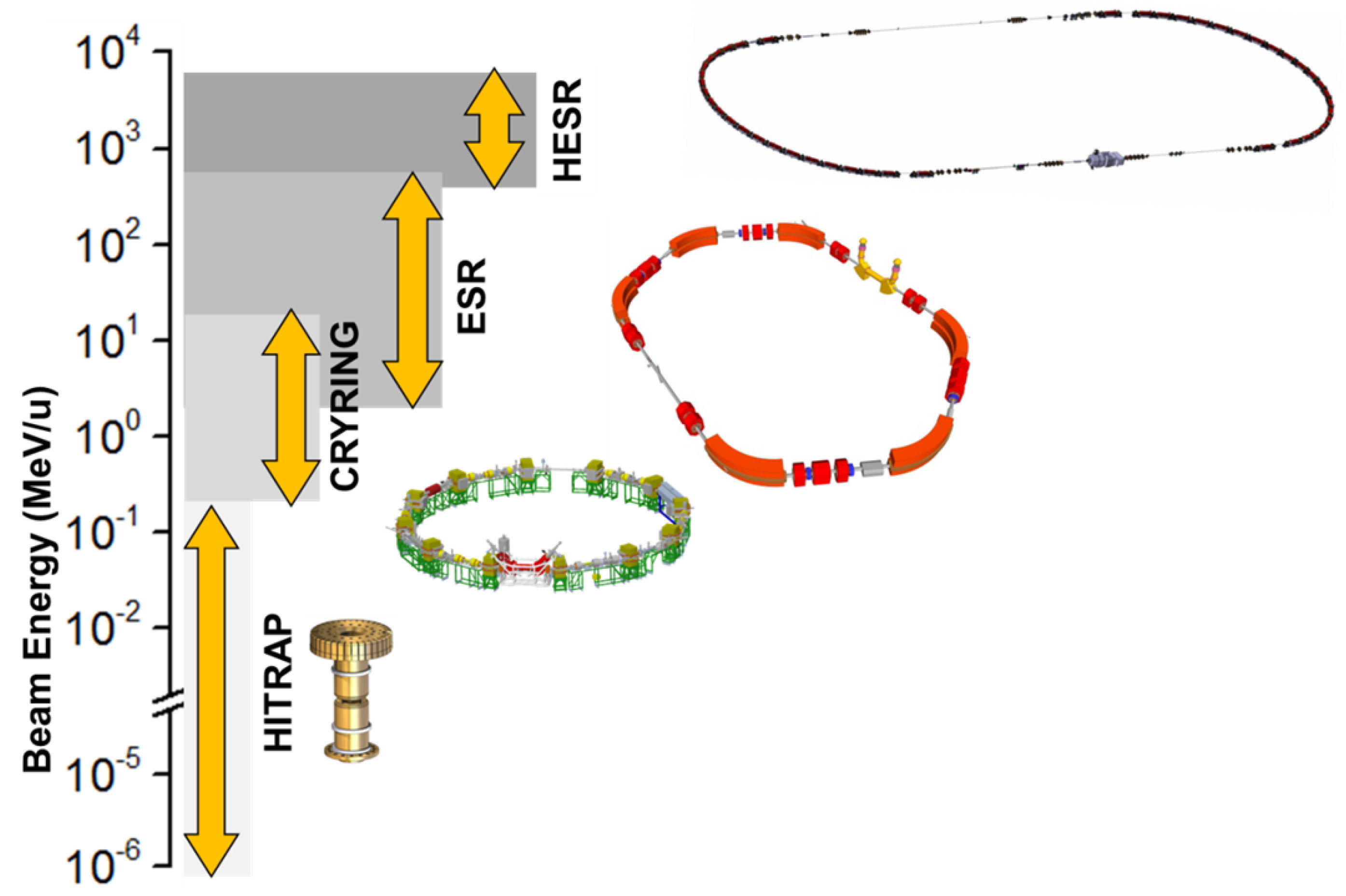
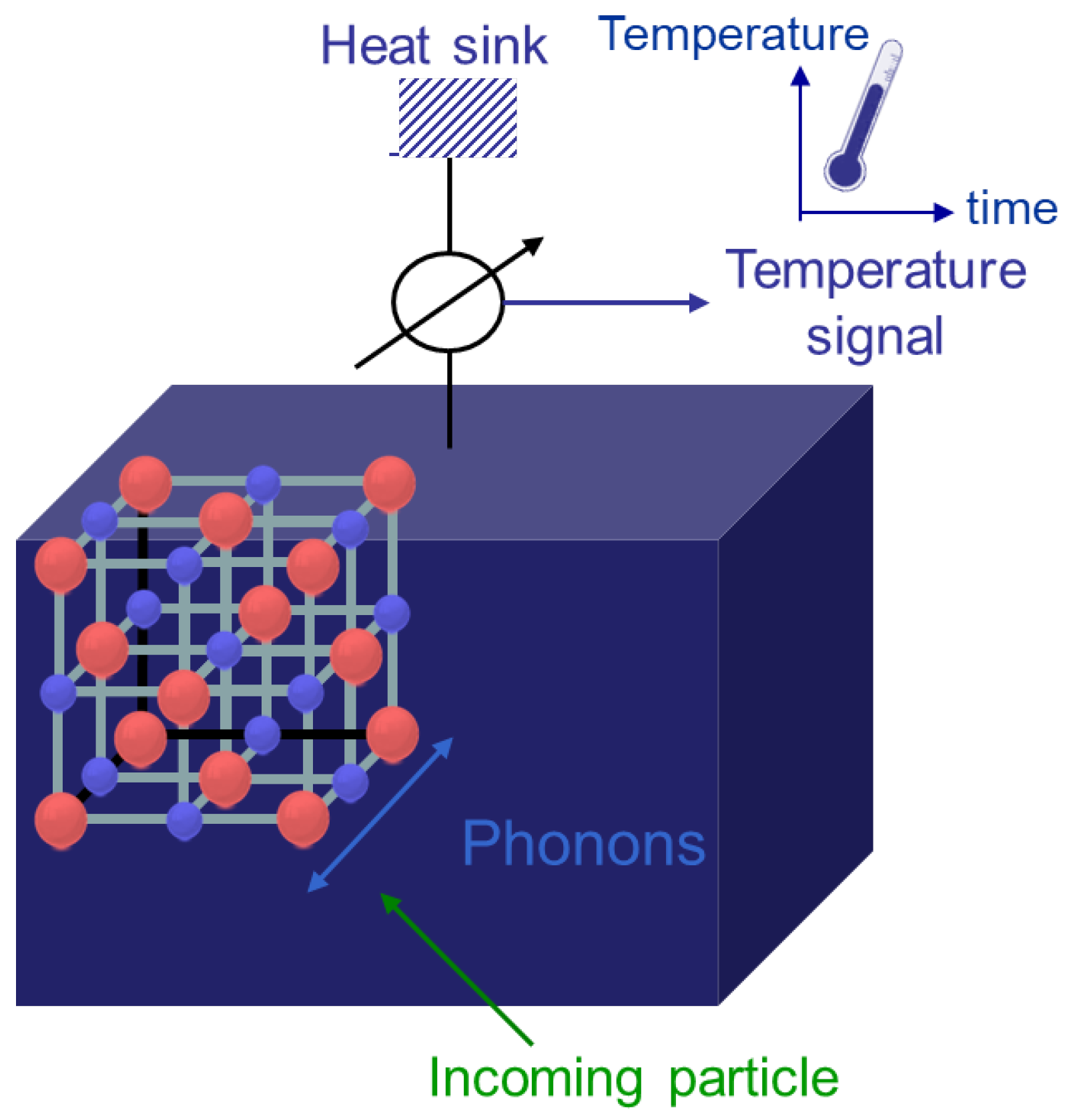
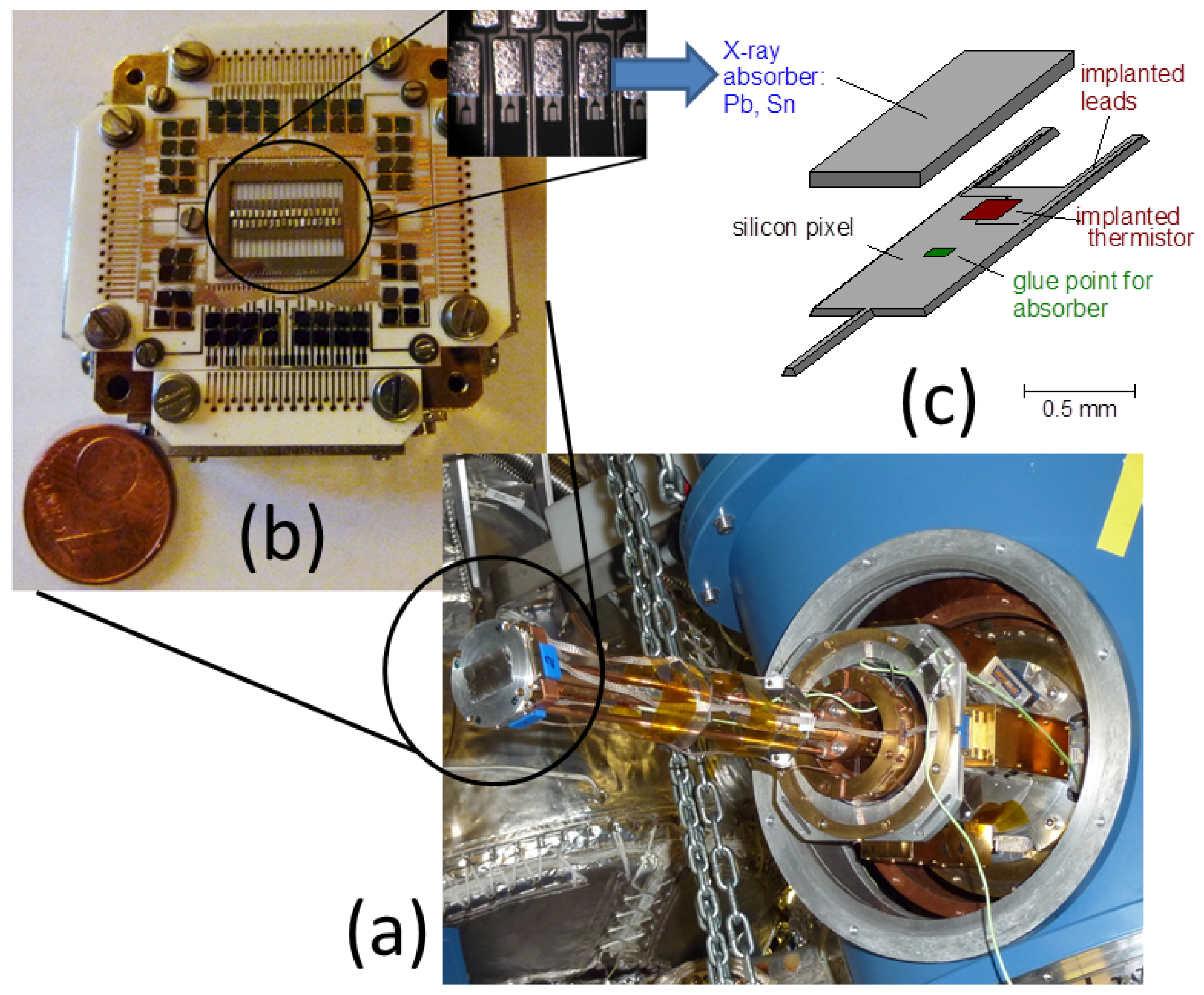
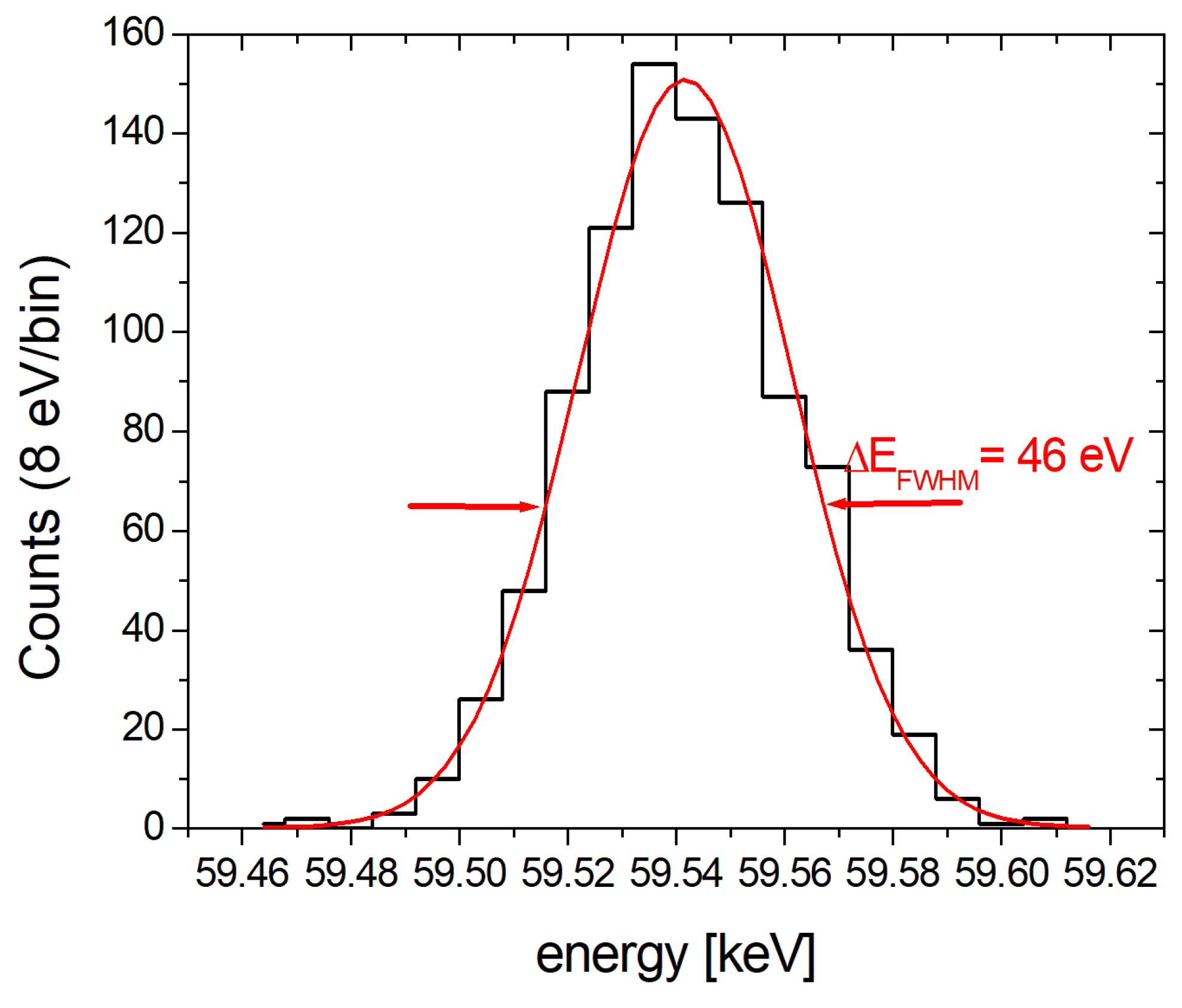
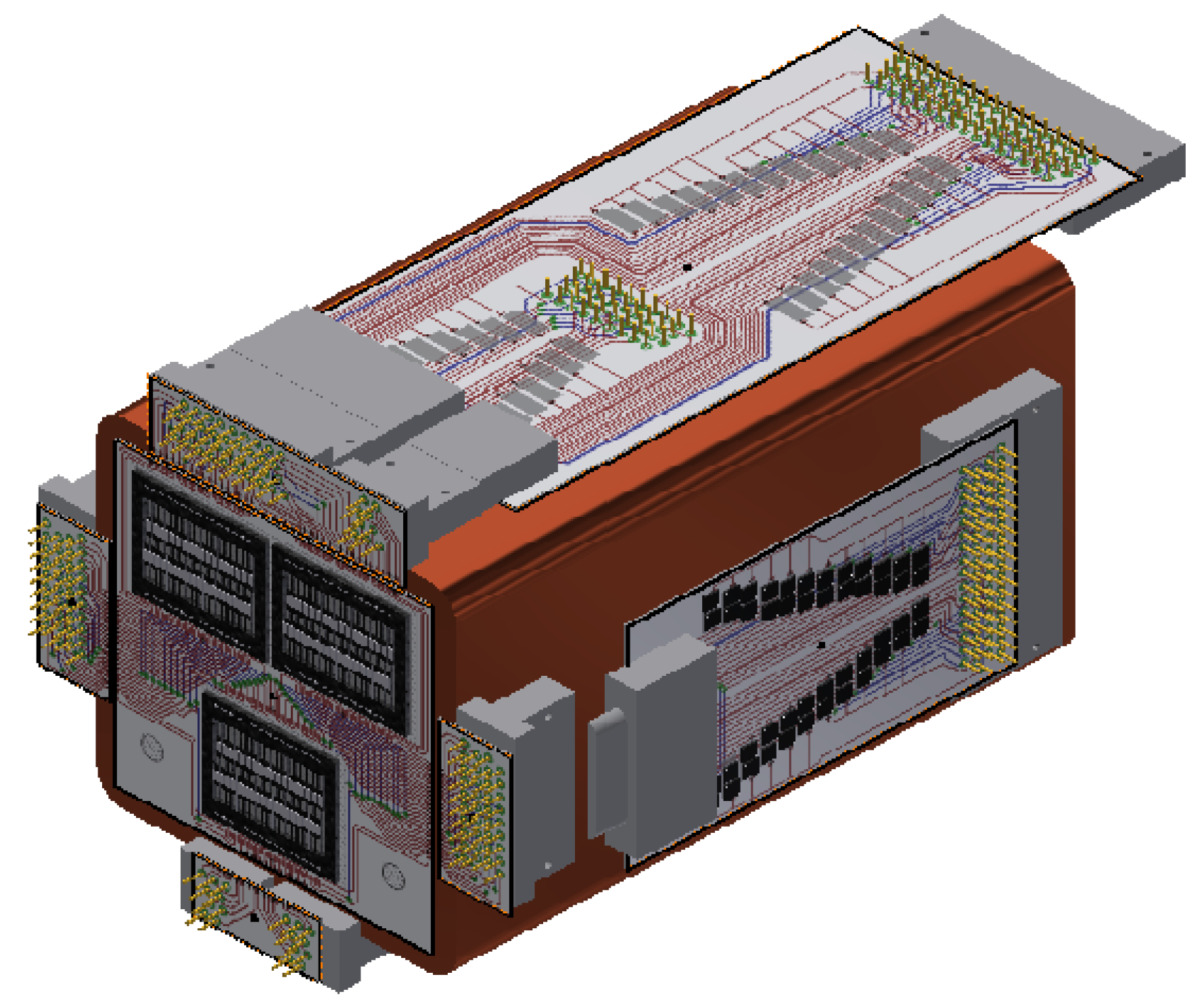
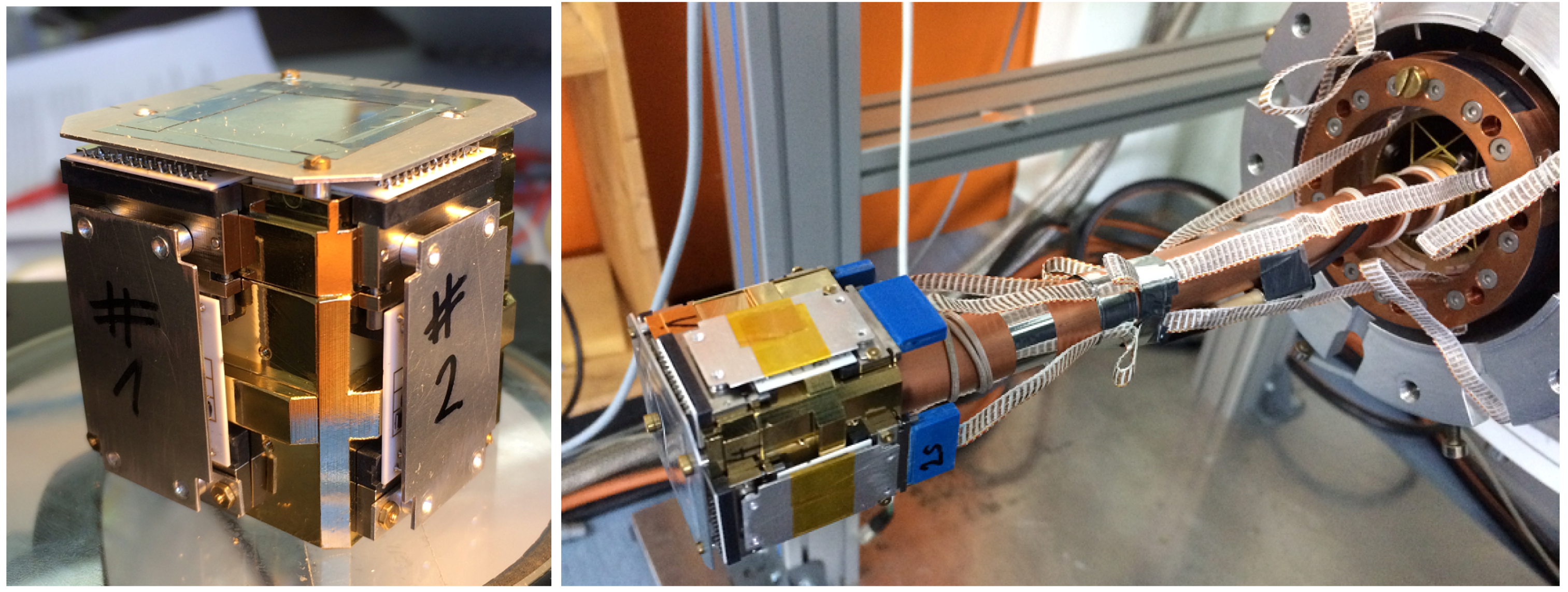
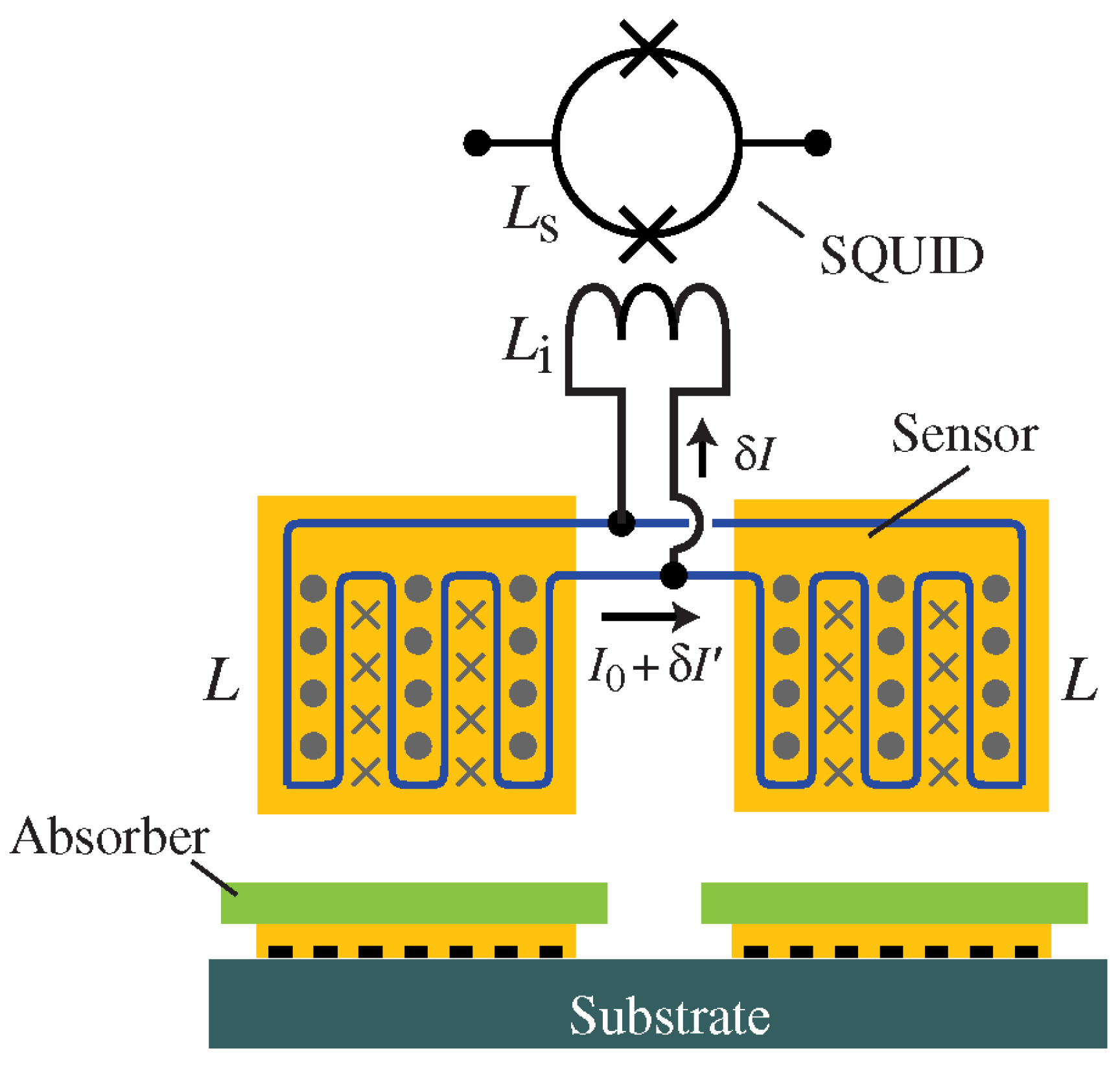
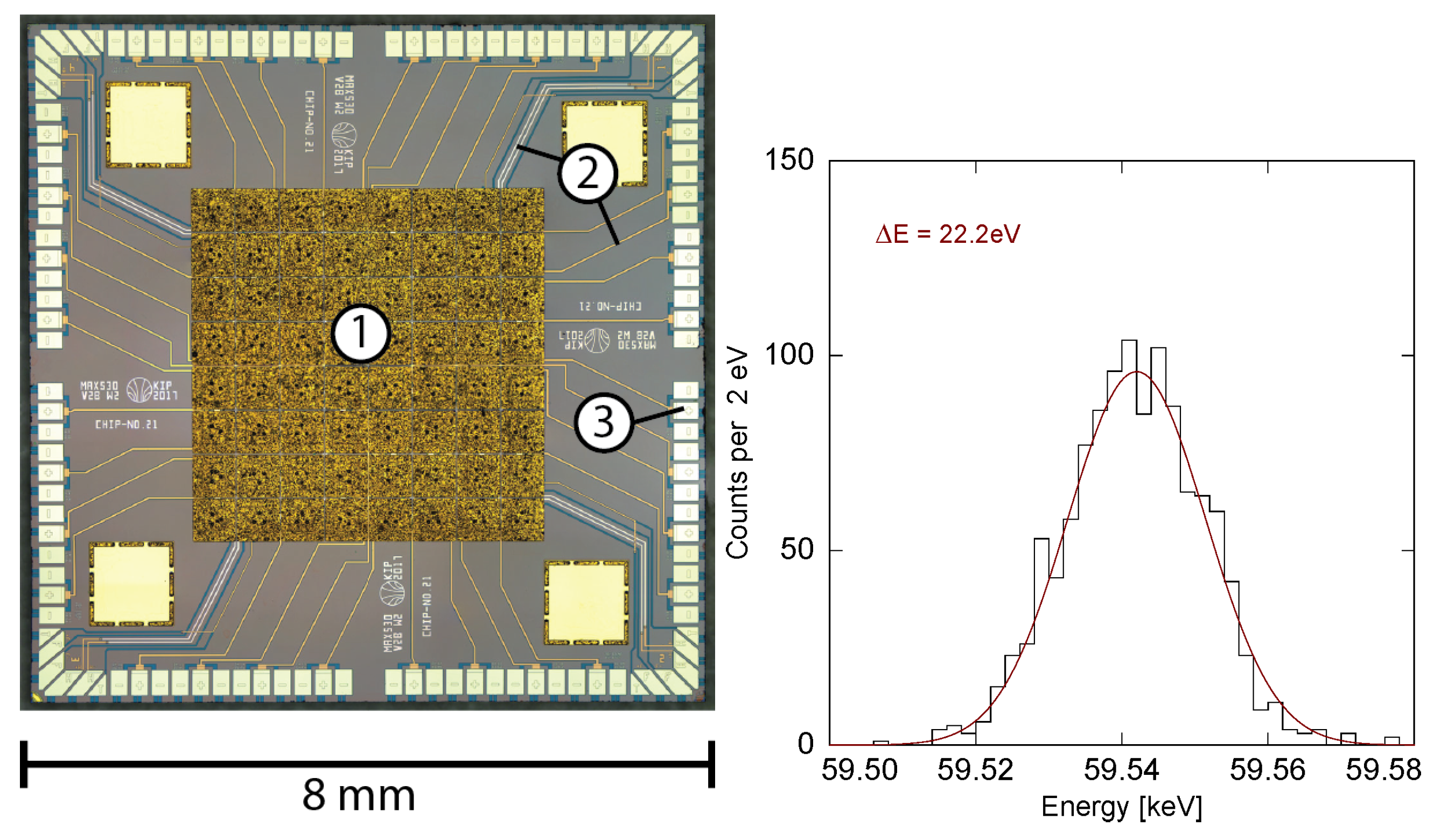
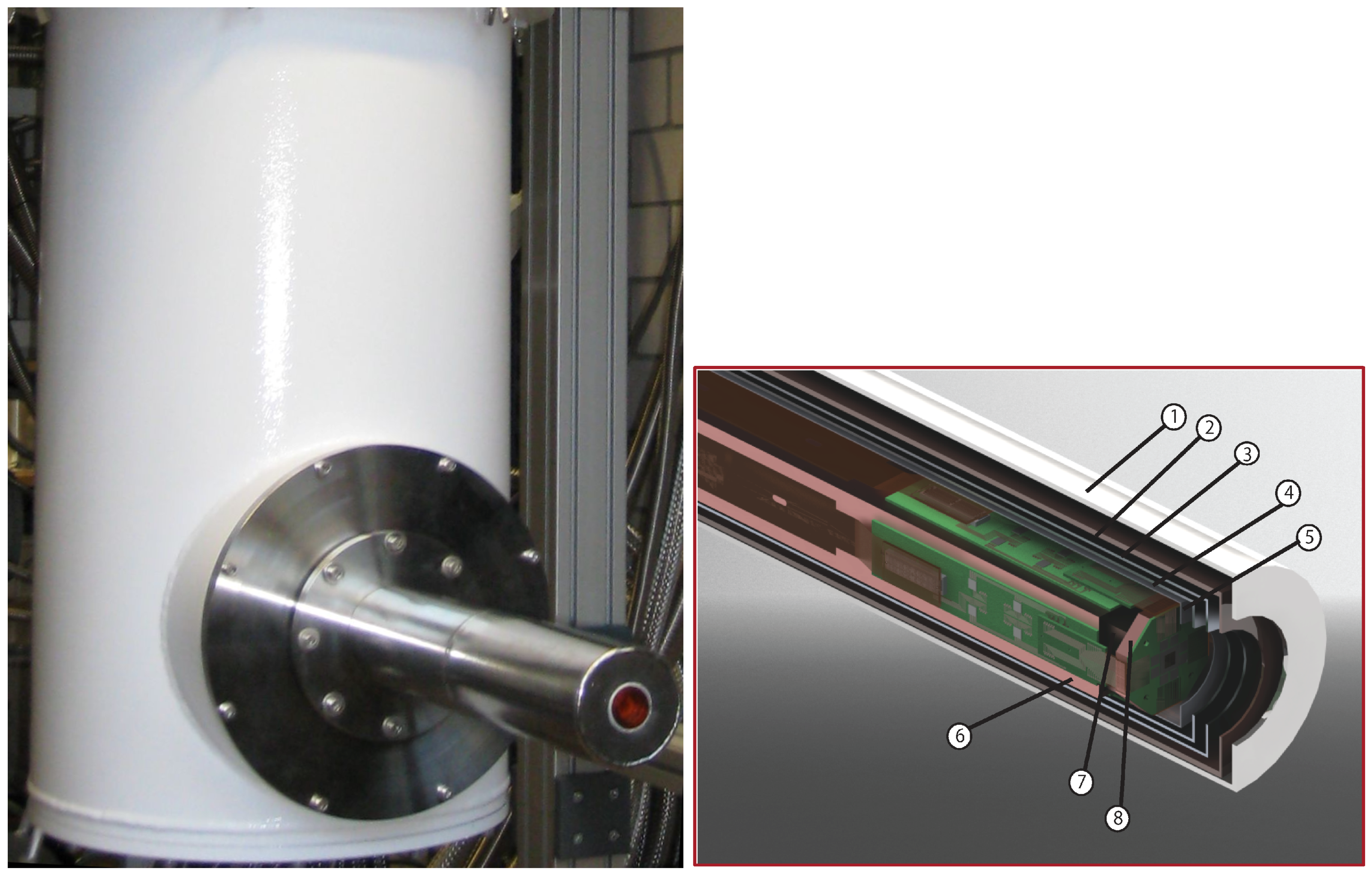
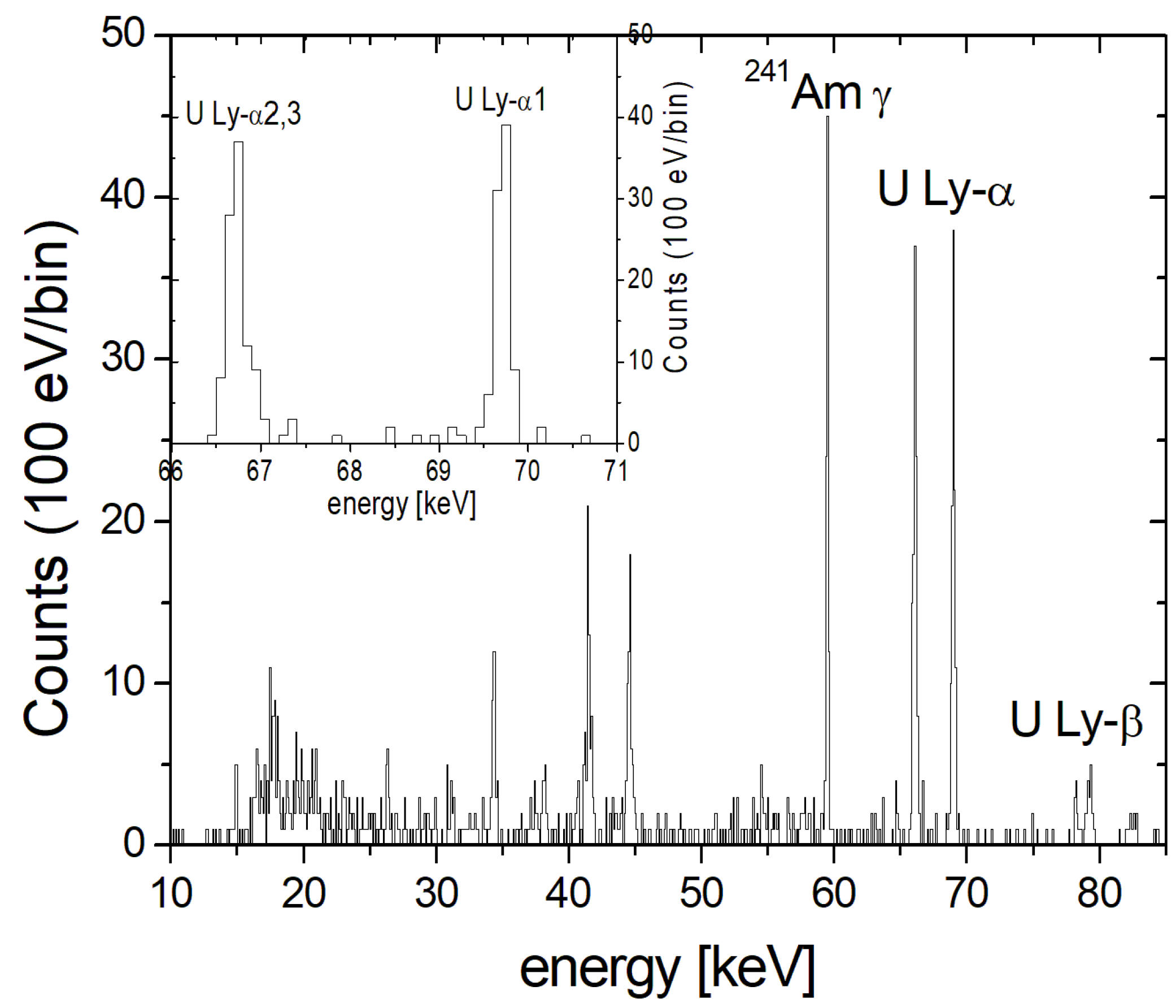
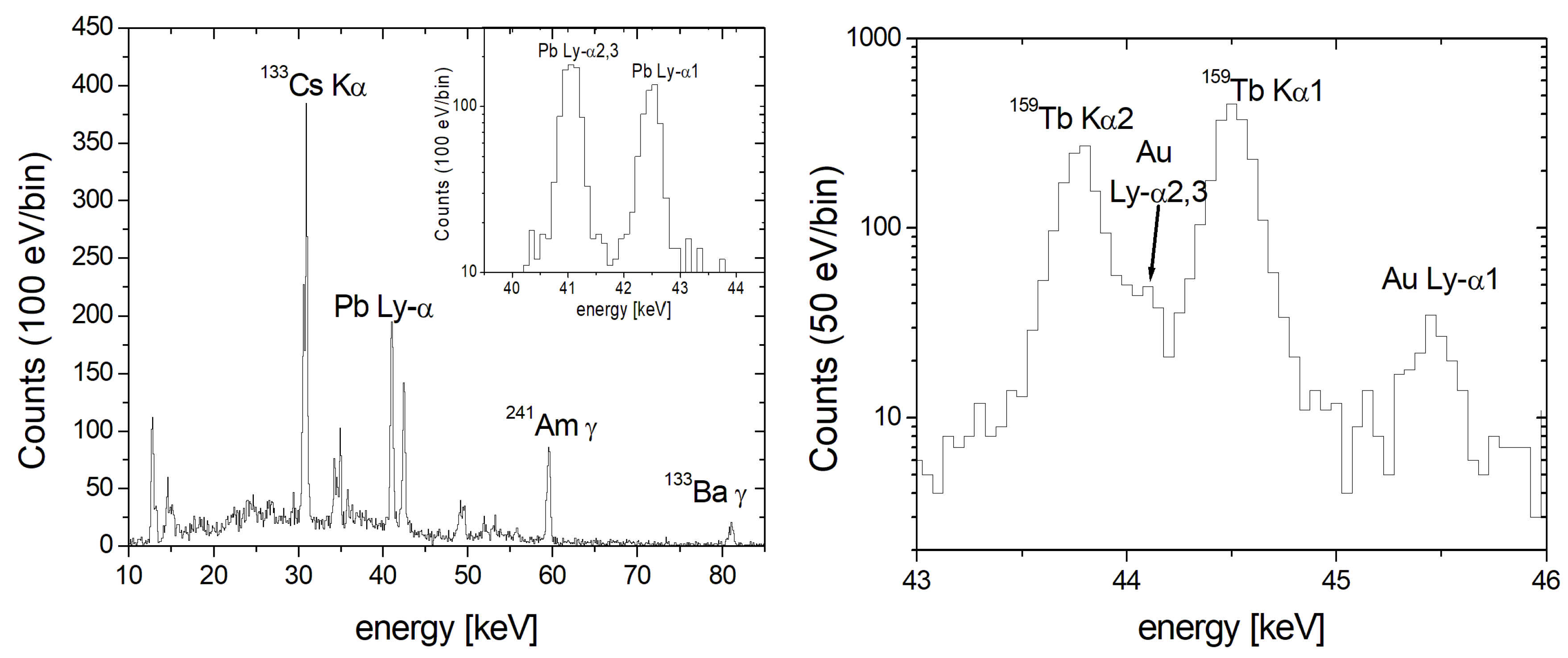
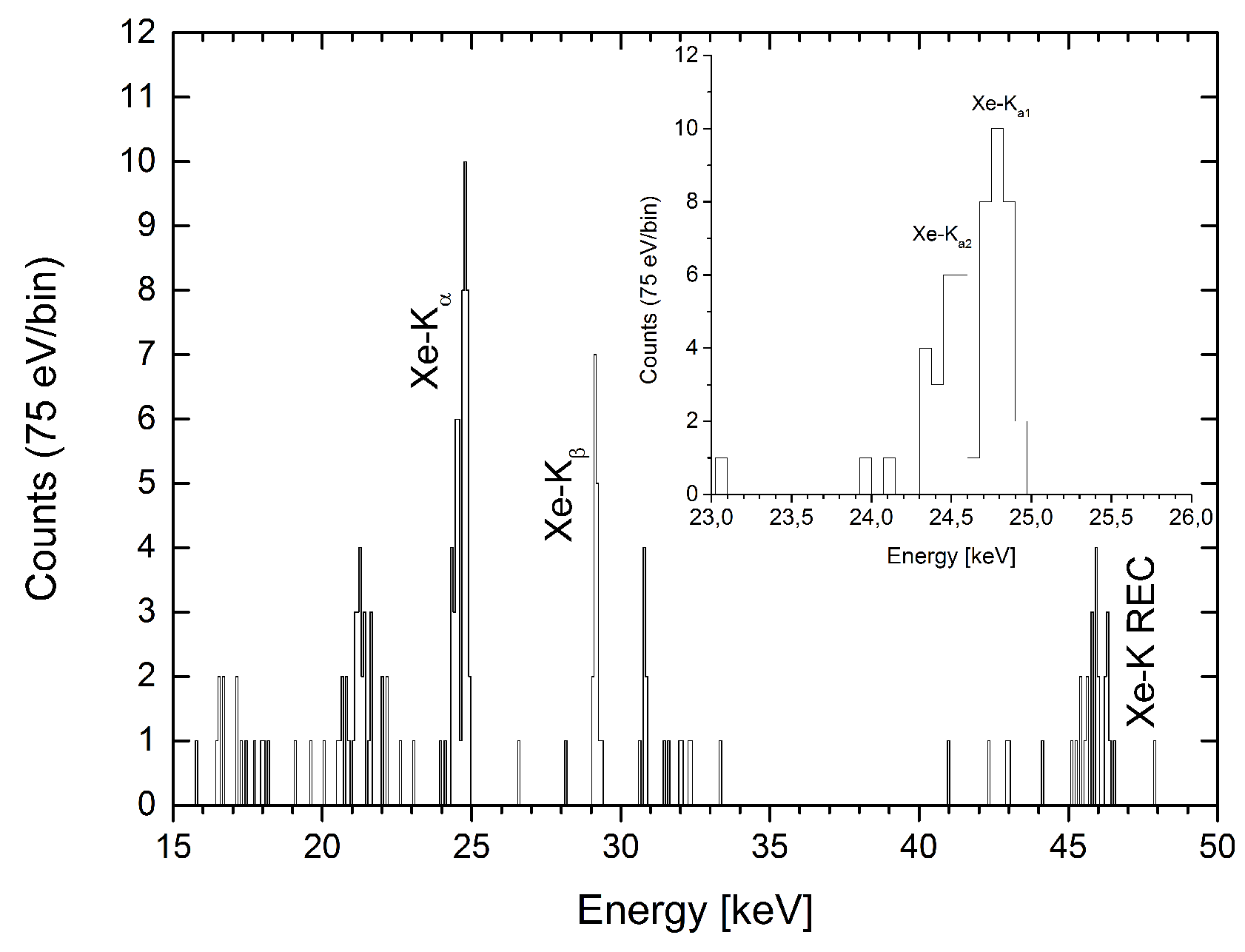
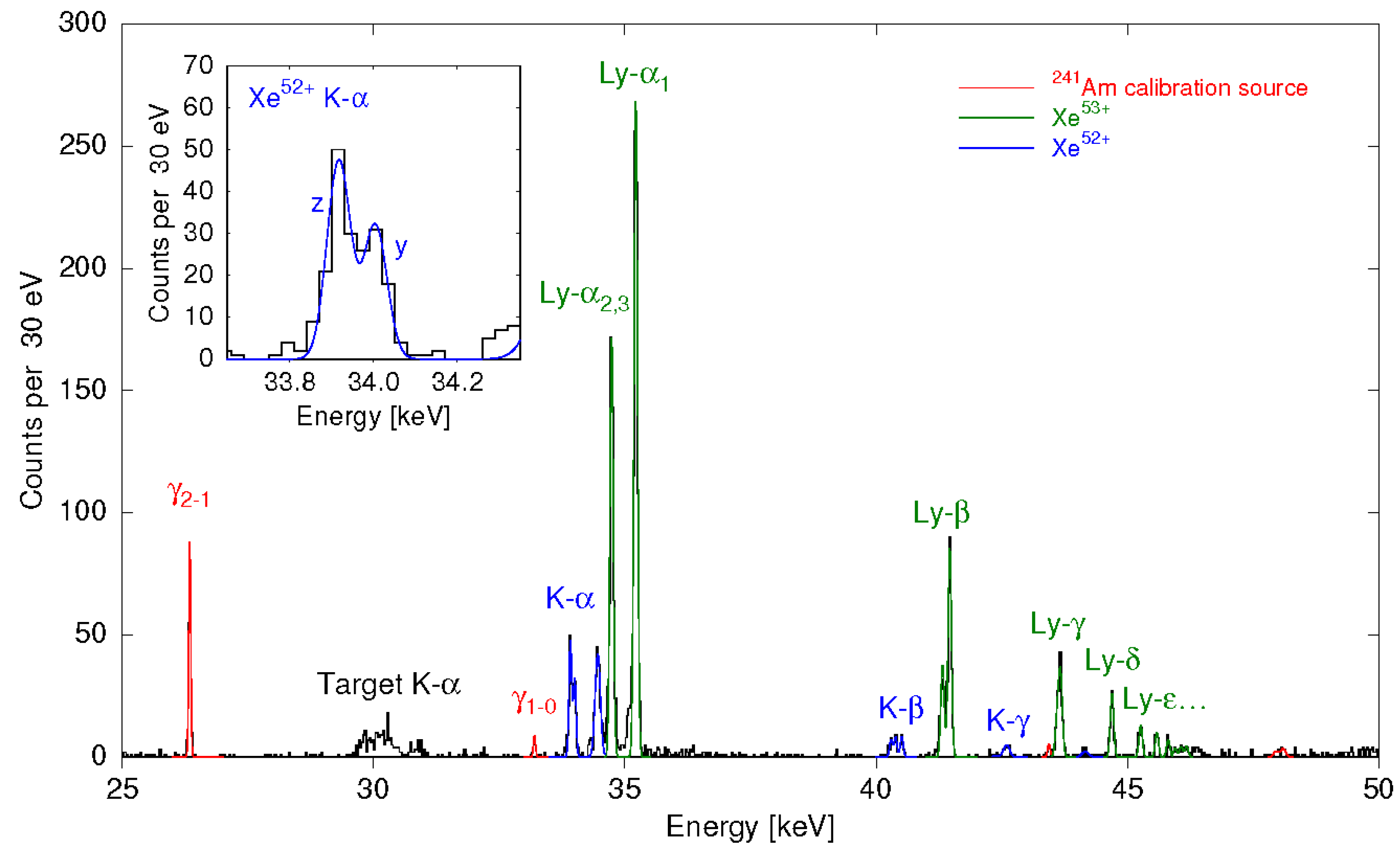
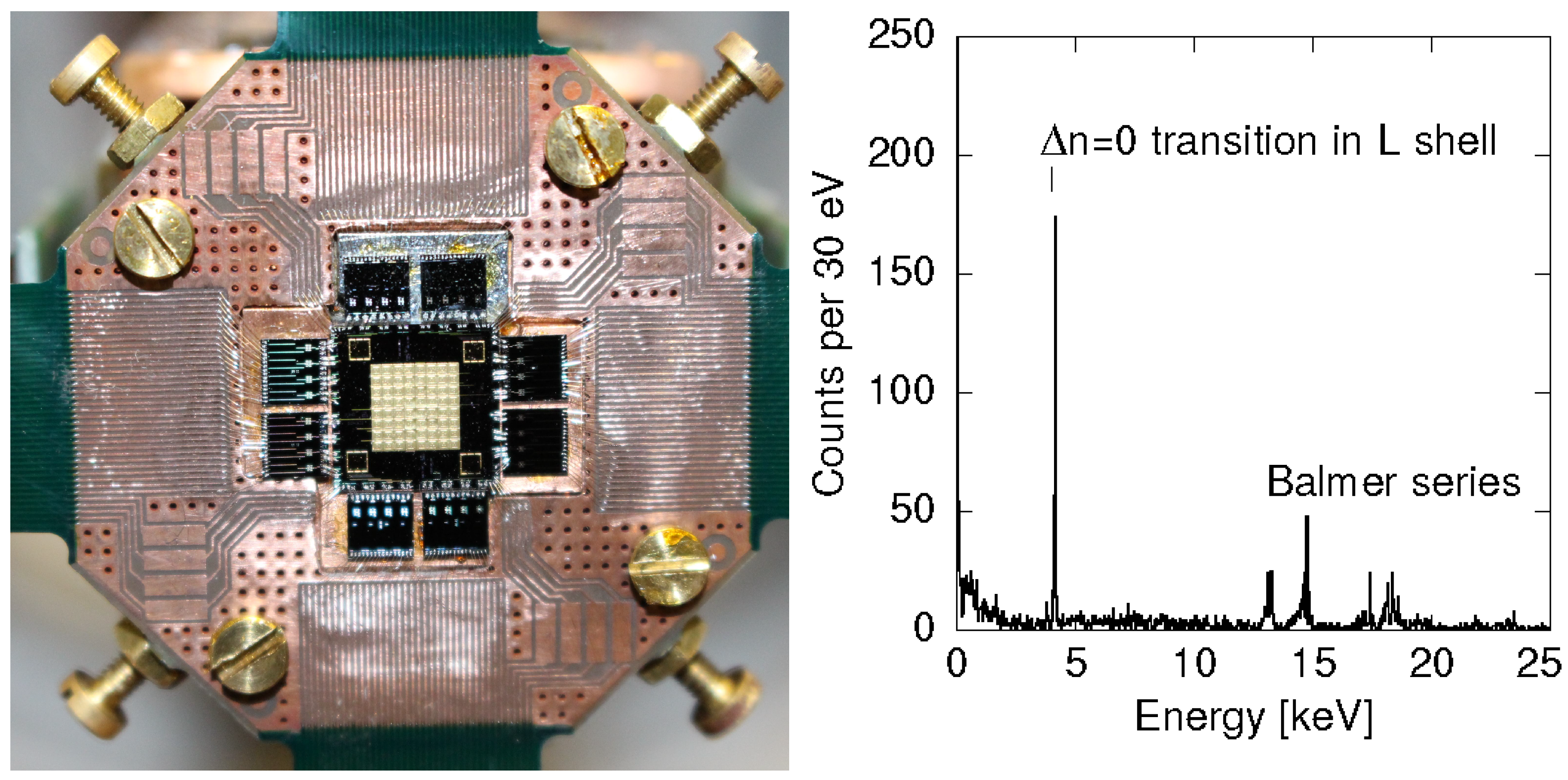
© 2018 by the authors. Licensee MDPI, Basel, Switzerland. This article is an open access article distributed under the terms and conditions of the Creative Commons Attribution (CC BY) license (http://creativecommons.org/licenses/by/4.0/).
Share and Cite
Kraft-Bermuth, S.; Hengstler, D.; Egelhof, P.; Enss, C.; Fleischmann, A.; Keller, M.; Stöhlker, T. Microcalorimeters for X-Ray Spectroscopy of Highly Charged Ions at Storage Rings. Atoms 2018, 6, 59. https://doi.org/10.3390/atoms6040059
Kraft-Bermuth S, Hengstler D, Egelhof P, Enss C, Fleischmann A, Keller M, Stöhlker T. Microcalorimeters for X-Ray Spectroscopy of Highly Charged Ions at Storage Rings. Atoms. 2018; 6(4):59. https://doi.org/10.3390/atoms6040059
Chicago/Turabian StyleKraft-Bermuth, Saskia, Daniel Hengstler, Peter Egelhof, Christian Enss, Andreas Fleischmann, Michael Keller, and Thomas Stöhlker. 2018. "Microcalorimeters for X-Ray Spectroscopy of Highly Charged Ions at Storage Rings" Atoms 6, no. 4: 59. https://doi.org/10.3390/atoms6040059
APA StyleKraft-Bermuth, S., Hengstler, D., Egelhof, P., Enss, C., Fleischmann, A., Keller, M., & Stöhlker, T. (2018). Microcalorimeters for X-Ray Spectroscopy of Highly Charged Ions at Storage Rings. Atoms, 6(4), 59. https://doi.org/10.3390/atoms6040059



